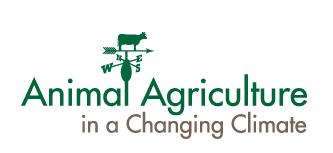 The 1941 USDA Yearbook in Agriculture was titled “Climate and Man”. All 1,214 pages in the book focus on the interdependency of agriculture and humanity with weather and climate. Even prior to the rise in global temperature seen in the latter half of the 20th century, it was understood that extreme weather events needed to be planned for and managed.
The 1941 USDA Yearbook in Agriculture was titled “Climate and Man”. All 1,214 pages in the book focus on the interdependency of agriculture and humanity with weather and climate. Even prior to the rise in global temperature seen in the latter half of the 20th century, it was understood that extreme weather events needed to be planned for and managed.
Related: Animal agriculture and climate change
Not only are these extreme events predicted to become more common and more extreme, but a high human population is increasing demand for finite resources such as land and water.
Changes in precipitation and temperature vary by region. In general the US is seeing more precipitation and the timing and intensity of precipitation is also changing. While global temperatures are increasing, it is the variability and intensity of temperatures that are of greatest consequence to animal agriculture.
Extreme weather events are expected to affect many areas of animal production.
- Farm Inputs: Drought and heat can devastate pastures or create hay and grain shortages which drive up prices. The same is true for wet and cool conditions. High temperature also also increases animal water consumption. This may occur at the same time there is limited water availability – either recharge to aquifers or runoff to streams and rivers used to water livestock.
- Animal Production: The impact of heat and humidity on animal physiology is well documented. Extreme heat generally results in higher animal mortality, but, possibly of greater concern is the important are the economic impacts to production such as daily weight gain and feed conversion efficiency.Heat and humidity can also impact an animal’s immune system making it more susceptible to disease and stress. In addition to direct effects on animal production, heat, humidity, and moisture drive pest and disease cycles. These changes can be spatial, temporal or change the intensity of the outbreak.
- Logistics: Many farm activities, such as moving feed to the farm, moving young stock to the farm or product off the farm, feeding and watering animals, keeping animals comfortable, moving manure to the fields, etc. depend upon weather conditions Flooding creates problems for manure management (both overtopping of manure storages and land application). Flooding can also take out roads and bridges which may impact labor supply or moving feed or animals into or out of the farm. High temperatures may impact when animals can be fed or moved. Power outages often accompany these extreme events – adding additional management challenges.
- Farm Exports: Market pricing of produce (meat, milk, eggs) is always a challenge but is even more of a challenge with unpredictable weather. Drought or flooding will result in increased feed prices and possibly a decrease in selling price of the farm products. The economic impact will depend on the geographic range and severity of the weather event.
It is clear that there are economic impacts of heat and humidity on animal agriculture (St. Pierre, 2003) using historic weather data. Current trends in weather offer an opportunity to reassess the impacts of weather on the many aspects of the farming enterprise. Site specific farm assessments are needed to evaluate the susceptibility of the farm from changing weather trends but must include a comprehensive picture of all the impacts weather and climate at the local, regional, national and global scale.
Educator Materials
If you would like to use the video, slides, or factsheet for educational programs, please visit the curriculum page for download links for this and other climate change topics.
Recommended Resources
Manure Management
- Climate change impacts on dairy manure systems (video, 28 min, Czymmek)
Beef
- USDA ARS Temperature Humidity Index (THI) forecast
- Iowa Beef Center case study of a 1995 heat event that killed feedlot cattle
Swine/Pigs
Dairy
-
- Heat Stress Dairy UMN
- [fact sheet] Economics of Heat Stress;
Poultry
- Global Warming: How Does It Relate to Poultry? (Dunkley, UGA, 2011 – revised 2014)
General – Animals and Farming
- US Drought Monitor
- Agriculture in a Changing Climate (USDA Climate Hubs)
- The Effects of Climate Change on Agriculture, Land Resources Water Resources, and Biodiversity (USDA, 2008)
- Agricultural Adaptation to a Changing Climate (USDA-ERS, 2012)
Acknowledgements
Author: David Schmidt, University of Minnesota schmi071@umn.edu
This page was developed as part of a project “Animal Agriculture and Climate Change” an extension facilitation project to increase capacity for ag professionals. It was funded by USDA-NIFA under award # 2011-67003-30206.

